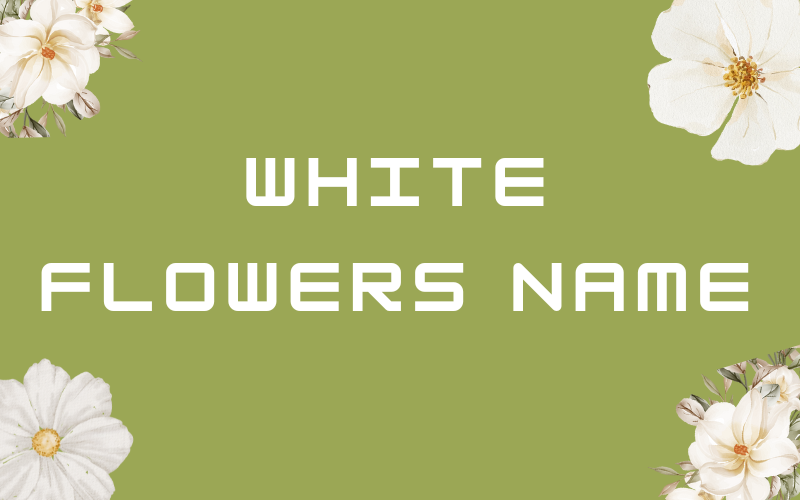White flowers are a common choice for important occasions like weddings and funerals. They also represent innocence, purity, and fresh starts. These are some names for white flowers that are renowned for their grace and beauty.
First, there’s the traditional white rose, which stands for purity, love, and respect. The second plant is the lily of the valley, which is prized for both its delicate beauty and sweet scent. The white peony, a metaphor for wealth and good fortune, comes in third.
White Flowers Name
Peonies
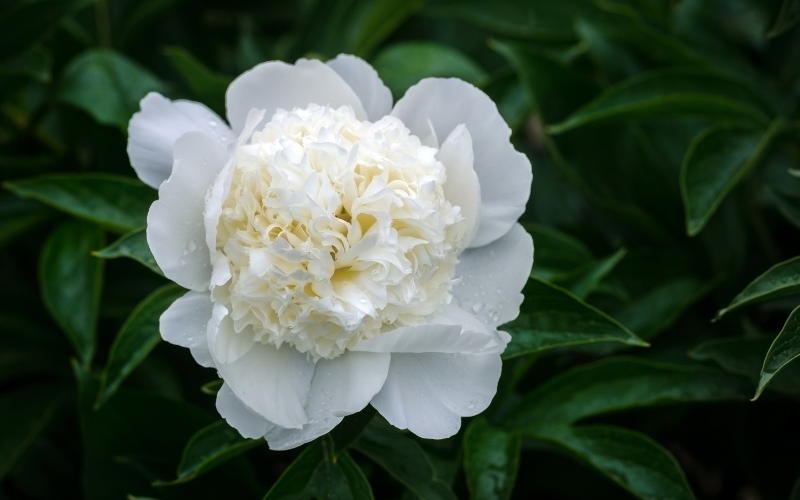
One of the most beautiful and fragrant flowers to bloom in late spring and early summer are peonies. They are available in several hues, such as white, pink, red, and even yellow.
Because of its big, eye-catching blooms, peonies are popular in gardens and as cut flowers in floral arrangements. Their soothing properties have led to their usage in traditional Chinese medicine as well. Peonies are a popular choice for gardeners since they are low maintenance and adaptable to many climates. They must be planted in a place that receives direct sunlight for at least six hours a day, and they need well-draining soil.
| Scientific Name | Paeonia |
| Native Range | Tibet, China, Siberia |
| Flowering Season | Late spring into early summer |
Dahlia
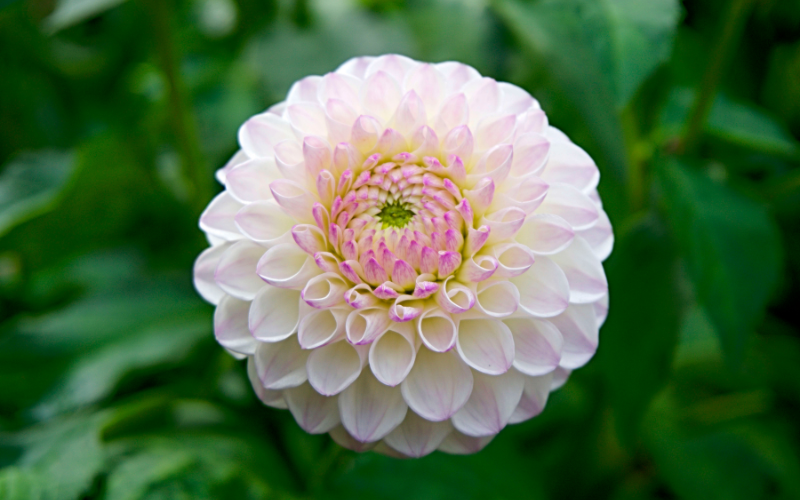
The white Dahlia is one of the most beautiful flowers to exist. Its delicate petals and pure color make it a sight to behold. The Dahlia flower is native to Mexico, but it is now widely grown in different parts of the world.
Its classic elegance makes it a popular option for flower arrangements and bridal bouquets. Additionally, white dahlias are associated with grace, expertise, and purity. They are ideal for formal occasions like weddings where you want your flower arrangements to stand out. It is understandable why gardeners and flower lovers alike favor the white dahlia.
| Scientific Name | Dahlia |
| Native Range | Mexico also some species can be found in Guatemala, Honduras, Nicaragua, El Salvador & Costa Rica |
| Flowering Season | Mid-Summer |
Moonflower
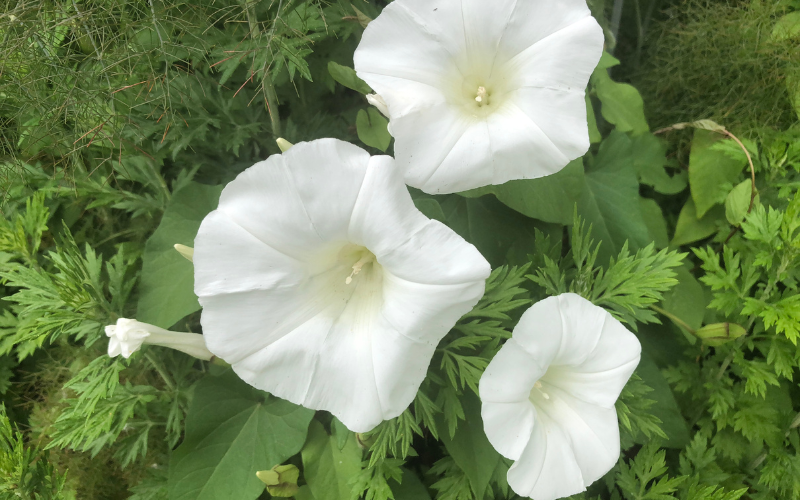
Moonflowers are lovely flowers with a soft, pleasant scent that blooms at night. Ipomoea alba is the scientific name for this flower, which is a member of the Ipomoea family. It can be grown all over the world, but its original habitat is the tropical and subtropical regions of the Americas.
Climbing to a height of up to 15 feet, moonflowers produce huge white flowers with a diameter of up to six inches. Normally closed during the day, the blossoms open when the sun sets. Because it blooms at night and fades when the sun rises, the moonflower is often referred to as the “evening glory”. Anybody will be charmed by the unique plant known as the moonflower.
| Scientific Name | Ipomoea alba |
| Native Range | North and South America, from Argentina to northern Mexico, Arizona, Florida and the West Indies |
| Flowering Season | Late summer and early fall |
White Hibiscus

The delicate and graceful white hibiscus flower is a unique and lovely bloom. Unlike the more common red or pink hibiscus, white hibiscus is a rare kind that is respected for its beauty. This flower, which represents purity and peace of mind, is frequently used in religious ceremonies and traditional festivals.
The white hibiscus features a striking yellow center surrounded by lush green leaves that complement its pristine white petals. It’s easy to understand why flower lovers and gardeners alike adore this stunning beauty. The grace and majesty of the white hibiscus will always amaze you, making it a stunning addition to any garden or floral arrangement.
| Scientific Name | Hibiscus rosa-sinensis |
| Native Range | Hawaiian Islands |
| Flowering Season | Year-around |
White Rose
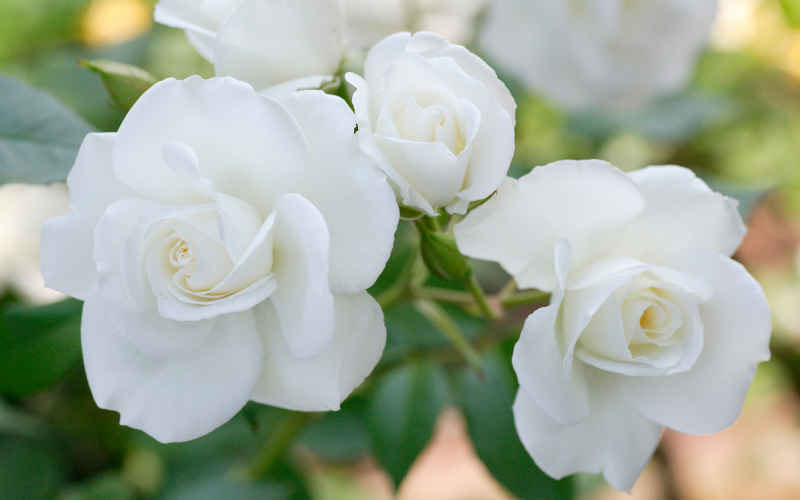
The white rose represents innocence, purity, and sincere love. Throughout history, it has been utilized for weddings, funerals, and other important ceremonies. It is a simple yet lovely flower that adds grace and charm to any arrangement.
The white rose is also thought to symbolize brand-new beginnings and initiatives. It is seen as a sign of rejuvenation and rebirth in several cultures. Its petals are frequently used in essential oils, fragrances, and other cosmetics. White roses are a classic and well-liked flower that will always have a particular place in our hearts, whether they are presented as gifts or used as decorations.
| Scientific Name | Rosa × alba |
| Native Range | Europe, including the Mediterranean area and parts of Asia |
| Flowering Season | Spring and summer |
Hydrangeas

Hydrangeas are a stunning and well-liked spring and summer flowering shrub. They are well-known for their huge, vibrant flowers, which are available in a range of hues such as pink, purple, blue, and white.
Hydrangeas are relatively simple to care for and are great for providing color and beauty to your yard. They are perfect for shaded parts of your garden that might not receive as much sunlight because they like moist, well-drained soil and partial to full shade.
| Scientific Name | Hydrangea |
| Native Range | New York and Massachusetts west through Illinois and Missouri, south to Louisiana and Florida, and in Kansas and Oklahoma |
| Flowering Season | Mid-spring through the late summer or early fall |
White Butterfly Bush
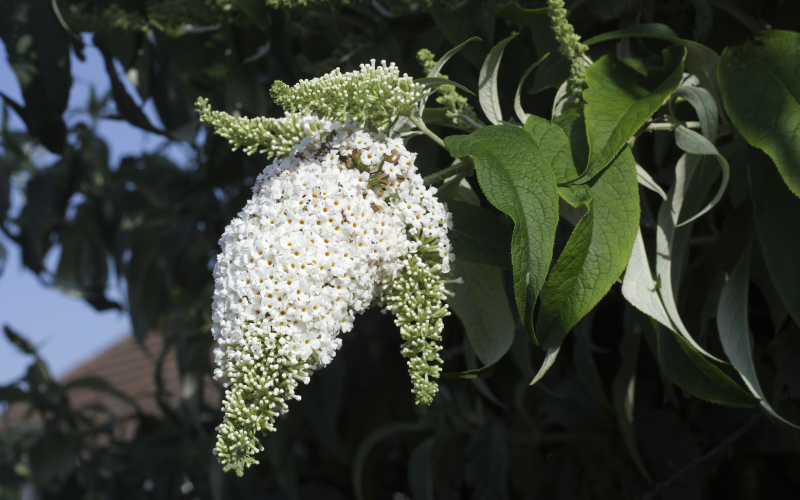
Gardeners and environmental enthusiasts enjoy the lovely flowering plant known as Buddleja davidii, or white butterfly bush. Butterflies and other pollinators are drawn to the number of fragrant white flowers produced by this shrub.
It blooms from midsummer to autumn and is a fast-growing shrub that can get up to 10 feet tall and wide. The white butterfly shrub is a fantastic option for both inexperienced and seasoned gardeners due to its ease of growth and maintenance. It can tolerate little shade, but it likes full sun exposure and well-drained soil. Pruning the plant regularly will boost growth while keeping it looking well-organized.
| Scientific Name | Buddleja davidii ‘White Profusion’ |
| Native Range | China |
| Flowering Season | Summer into fall |
White Dianthus
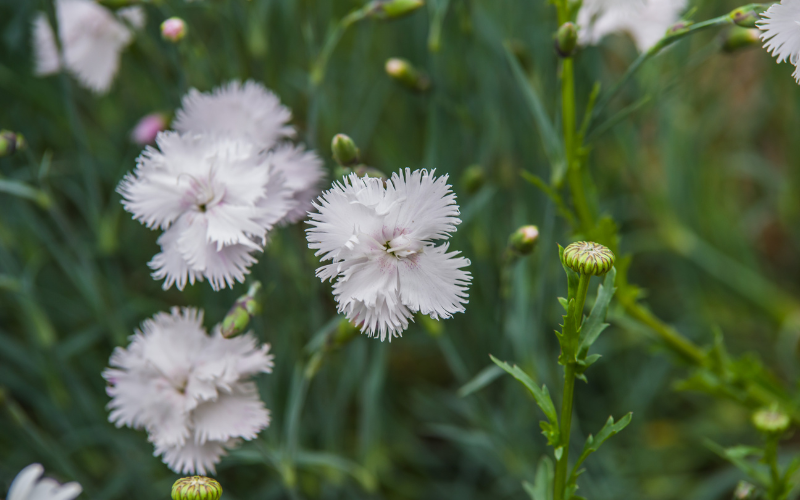
The White Dianthus is a lovely and easy-to-grow flower that will bring elegance and beauty to any garden or floral arrangement, whether you are a seasoned gardener or a beginner. is a lovely flower that has delighted gardens for ages. This carnation family flower is appreciated for its beautiful white petals and lovely fragrance.
This flower can bloom for several months during the growing season if properly cared for. These flowers are also low-maintenance, requiring only regular watering and occasional fertilization. White Dianthus is a lovely and easy-to-grow flower that will bring elegance and beauty to any garden or floral arrangement, whether you are a seasoned gardener or a beginner.
| Scientific Name | Dianthus chinensis |
| Native Range | Europe |
| Flowering Season | Early Spring, Spring, Late Spring, Summer, Autumn, Late Summer. Plant Habit |
White Lobelia
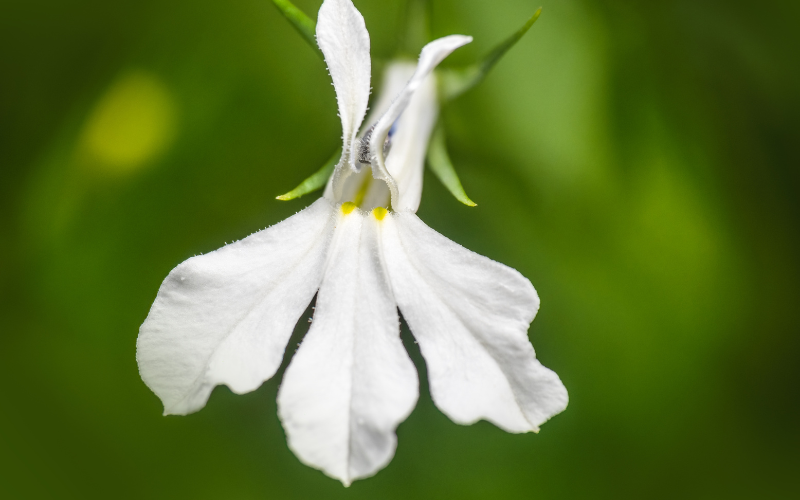
White Lobelia is a lovely perennial wildflower native to North America’s wetlands and moist environments. The beautiful white flowers and long, slender leaves identify the shrub.
It can bloom from mid-summer to early autumn and develops to reach around three feet tall. Because of its attractive significance, white lobelia is frequently used in landscaping and gardening, but it also has medicinal benefits. For ages, the plant has been utilized as a natural cure for respiratory illnesses such as asthma and bronchitis. It is also used to alleviate stress and promote relaxation.
| Scientific Name | Lobelia siphilitica |
| Native Range | North America |
| Flowering Season | Late summer to early fall |
Tulip

The white tulip is a symbol of purity, innocence, and new beginnings. It is a beautiful flower that is often used in wedding bouquets, as a gift for someone special, or as a decorative element in homes and gardens.
The white tulip is a perfect representation of a fresh start, making it a popular choice for those looking to start a new chapter in their lives. The simplicity and elegance of the white tulip make it a timeless flower that is loved by many. In some cultures, the white tulip is also used to represent forgiveness and peace, making it a meaningful choice for those seeking to make amends or bring peace to a situation.
| Scientific Name | Tulipa |
| Native Range | Central Asia |
| Flowering Season | Spring |
Angel’s Trumpet
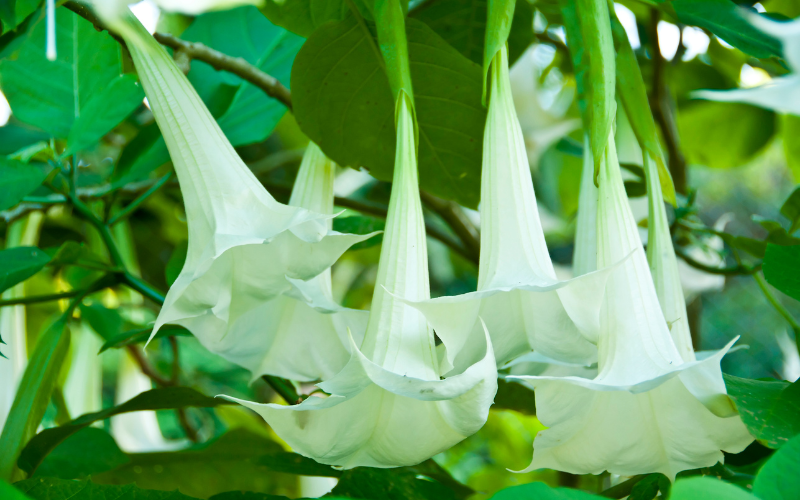
The Angel’s Trumpet is a beautiful flower. It is scientifically known as Brugmansia. It is native to South America. The flowers of Angel’s Trumpet can be quite large, reaching up to 12 inches (30 cm) in length.
They come in various colors, including white, yellow, pink, orange, and peach. Angel’s Trumpet thrives in warm climates and prefers well-draining, fertile soil. They require plenty of sunlight to produce abundant flowers.
| Scientific Name | Brugmansia suaveolens (Humb. & Bonpl. ex Willd. |
| Native Range | South America, particularly the Andes |
| Flowering Season | Summer into fall |
Angelonia
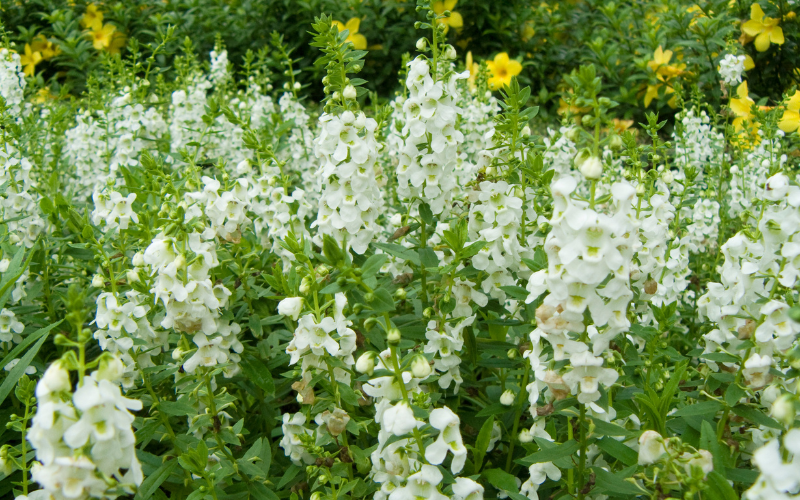
Angelonia is a popular and charming flowering plant. It is also known as Summer Snapdragon. It is Native to Central and South America, Angelonia. They typically grow to a height of about 12 to 24 inches (30 to 60 cm).
The flower colors include shades of purple, blue, pink, white, and bicolor. Angelonia flowers bloom profusely from late spring to fall. Angelonia thrives in full sun and well-draining soil.
| Scientific Name | Angelonia |
| Native Range | Mexico and the West Indies |
| Flowering Season | Late spring through fall |
Delaware Valley White Azalea
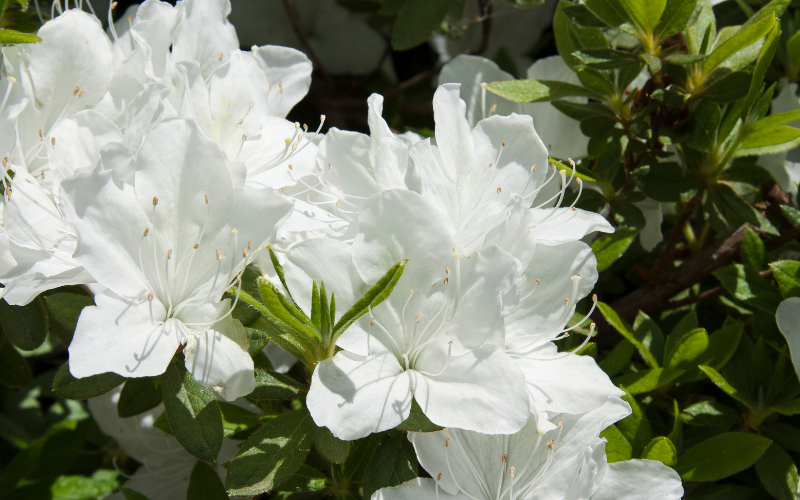
The white azalea from Delaware Valley is a stunning and well-liked flower. It is native to the eastern part of the US. The springtime is when Delaware Valley White Azalea usually blooms.
When fully grown, this azalea cultivar can reach heights and widths of 4 to 6 feet (1.2 to 1.8 meters). These flowers grow best in filtered sunlight with some shade. They favor soil that is rich in organic materials, well-draining, and acidic.
| Scientific Name | Rhododendron indicum ‘Delaware Valley White’ |
| Native Range | Asia and North America |
| Flowering Season | Spring |
Gardenia
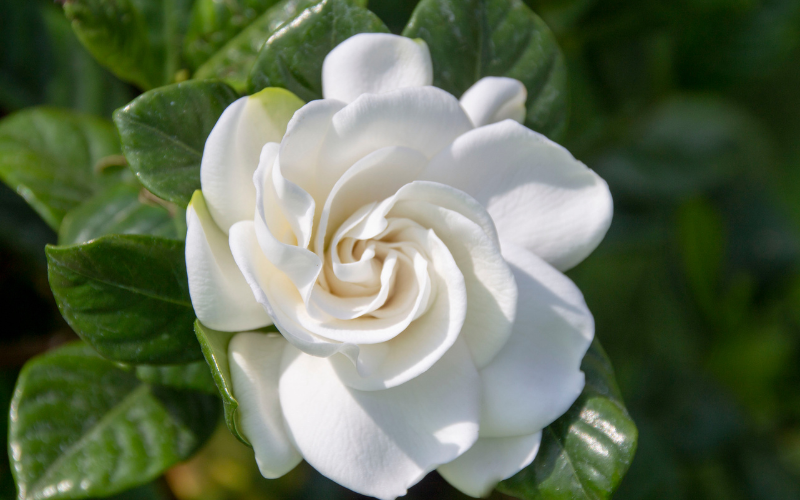
The Gardenia is a beautiful flower. It is native to tropical and subtropical regions of Africa, Asia, and the Pacific Islands. They can be quite large, ranging from 2 to 5 inches (5 to 13 cm) in diameter.
Gardenia flowers typically bloom during late spring and continue through the summer. Gardenias prefer warm, humid climates and thrive in well-draining, acidic soil. Many Gardenia varieties can also be grown indoors as houseplants.
| Scientific Name | Gardenia jasminoides |
| Native Range | Africa, Asia, and Pacific islands |
| Flowering Season | Late spring through the summer |
Heliotrope
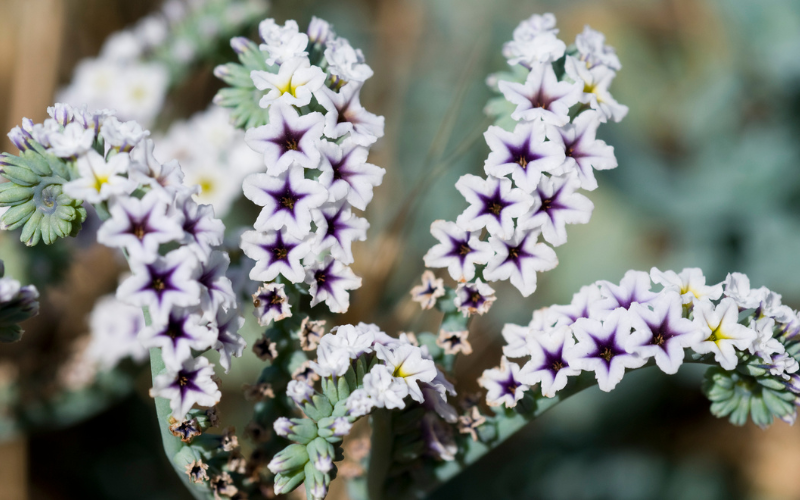
The Heliotrope flower is a fragrant and charming flowering plant. It is scientifically known as Heliotropium arborescens. It is native to Peru. They come in shades of purple, lavender, blue, and white.
Heliotrope plants usually start blooming in late spring and continue throughout the summer. Heliotrope thrives in full sun to partial shade and prefers well-draining, fertile soil. Heliotrope can also be grown in containers and hanging baskets, making it versatile.
| Scientific Name | Heliotropium indicum |
| Native Range | Americas, from Canada to Argentina, including the West Indies and Hawaii |
| Flowering Season | Summer |
Lily of the Valley
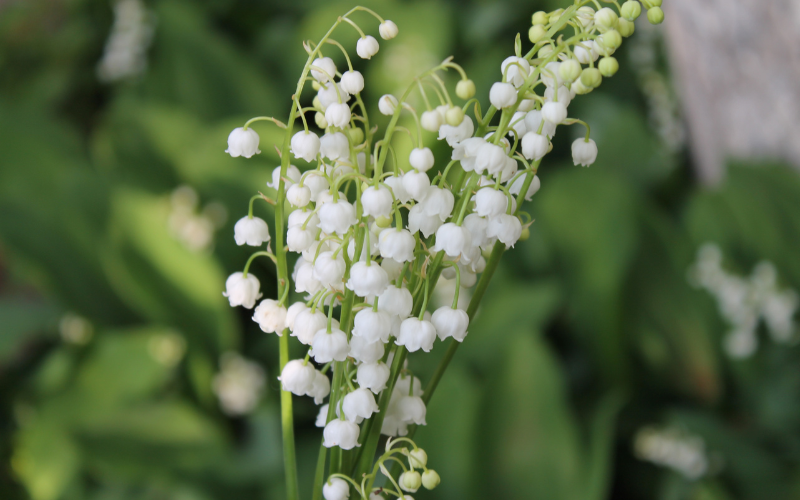
The Lily of the Valley is a beautiful flower. It is native to Europe and certain parts of Asia. Lily of the Valley plants are low-growing. The flowers are small, about 1 cm in diameter.
Lily of the Valley typically blooms in late spring to early summer. They can be grown in various conditions, from woodland gardens to container plantings.
| Scientific Name | Convallaria majalis |
| Native Range | Asia and Europe |
| Flowering Season | Late spring to early summer |
Magnolia Flower
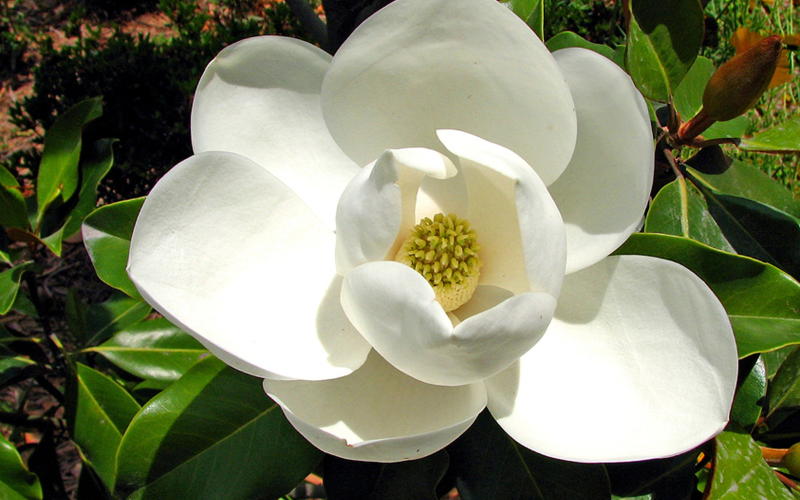
Magnolia is a beautiful flower. It is native to East Asia, the Americas, and some parts of Southeast Asia. Magnolia flowers come in a variety of colors, including white, pink, and purple.
Magnolia flowers usually bloom in spring, although the specific timing can vary based on the species and the local climate. Magnolias prefers well-draining soil and a location with at least partial sun to full sun exposure.
| Scientific Name | Magnolia grandiflora |
| Native Range | North America, Asia |
| Flowering Season | Spring, summer |
Nemesia
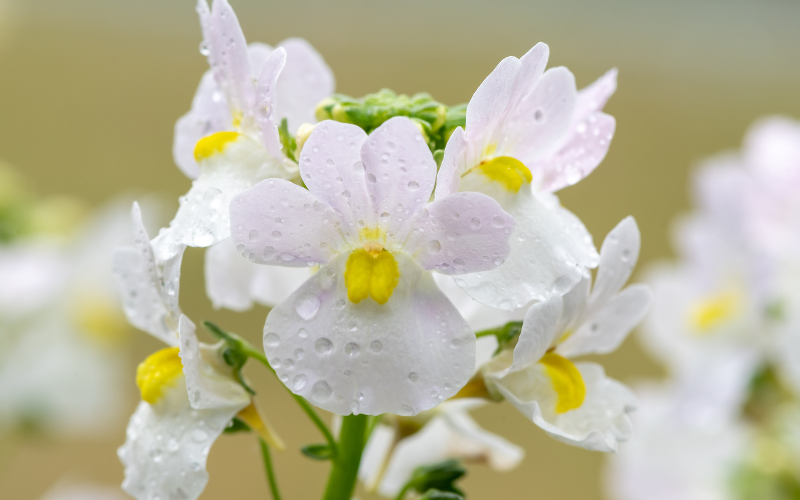
Nemesia is a beautiful and popular flower. It is native to South Africa. Nemesia flowers come in a variety of colors, including shades of purple, pink, red, orange, yellow, and white.
Nemesias typically bloom in spring and continue flowering into early summer. Nemesias prefers full sun to partial shade and well-draining soil. Nemesias are generally low-maintenance plants.
| Scientific Name | Nemesia |
| Native Range | South Africa |
| Flowering Season | Late spring until the first frost |
Petunia
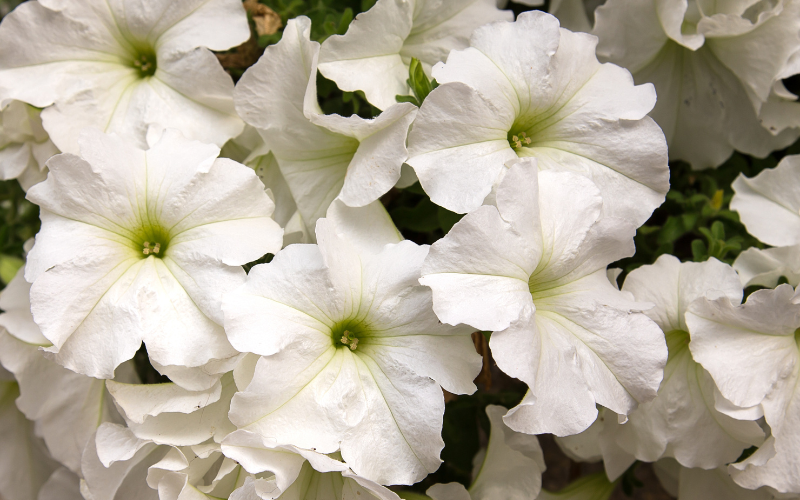
Petunia is a charming flowering plant. It is native to South America, particularly Argentina and Uruguay, Petunias. Petunia flowers come in a wide array of colors, including shades of pink, purple, red, white, yellow, and even multicolored varieties.
They typically bloom from late spring until the first frost in the fall. With proper care, they can provide continuous blooms throughout the growing season.
| Scientific Name | Petunia × atkinsiana |
| Native Range | South America |
| Flowering Season | Spring |
Sweet Alyssum
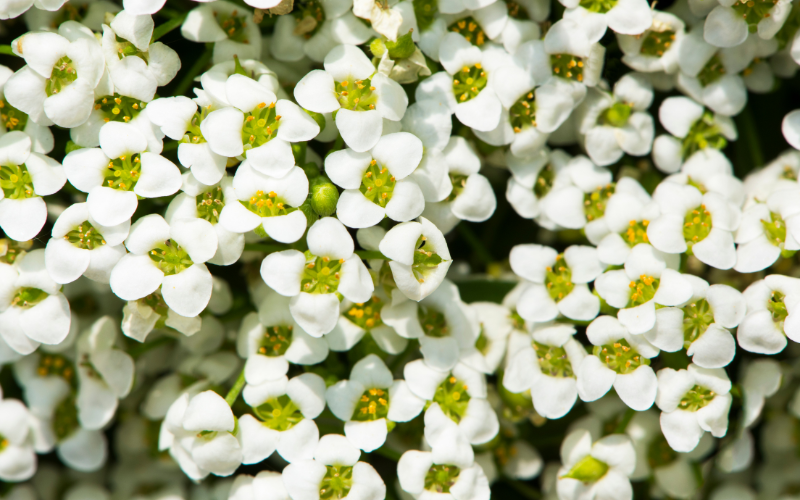
The Sweet Alyssum is a beautiful flower. It is scientifically known as Lobularia maritima (previously known as Alyssum maritimum). It is native to the Mediterranean region.
The flowers come in various shades, including white, pink, lavender, and purple. Sweet Alyssum is a cool-season annual that thrives in spring and fall. It can also bloom in mild climates throughout the winter months.
| Scientific Name | Alyssum |
| Native Range | Mediterranean, Canary Islands and Azores |
| Flowering Season | Early spring once all danger of frost has passed |
Phlox
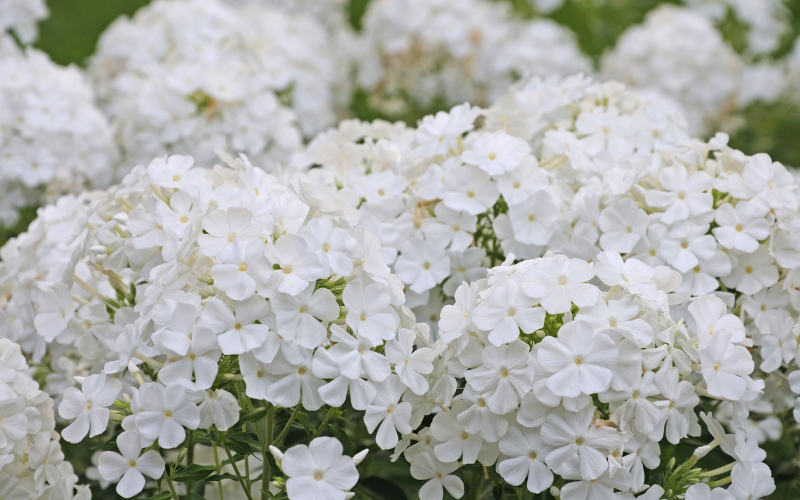
Phlox is a stunning and vibrant flower. It is also known as “the flame flower.” Phlox flowers come in a range of hues, including shades of pink, purple, blue, white, and red. Their fragrant blooms attract butterflies and hummingbirds.
Phlox flowers are also incredibly versatile, thriving in both full sun and partial shade conditions. They are relatively low-maintenance, requiring regular watering and occasional pruning to promote healthy growth.
| Scientific Name | Phlox |
| Native Range | New York to Iowa south to Georgia, Mississippi and Arkansas |
| Flowering Season | Summer |
Virginia Sweetspire

Virginia Sweetspire is a beautiful flower. It is scientifically known as Itea virginica. It is native to the southeastern United States. Virginia Sweetspire typically blooms in late spring to early summer.
The flowering period is relatively short, but the charming and graceful appearance of the flower clusters makes them a highlight during this time. The flowers of Virginia Sweetspire are small and delicate, with a creamy white to pale green color.
| Scientific Name | Itea virginica |
| Native Range | Southeastern United States |
| Flowering Season | Late spring to Early summer |
White Buttercup
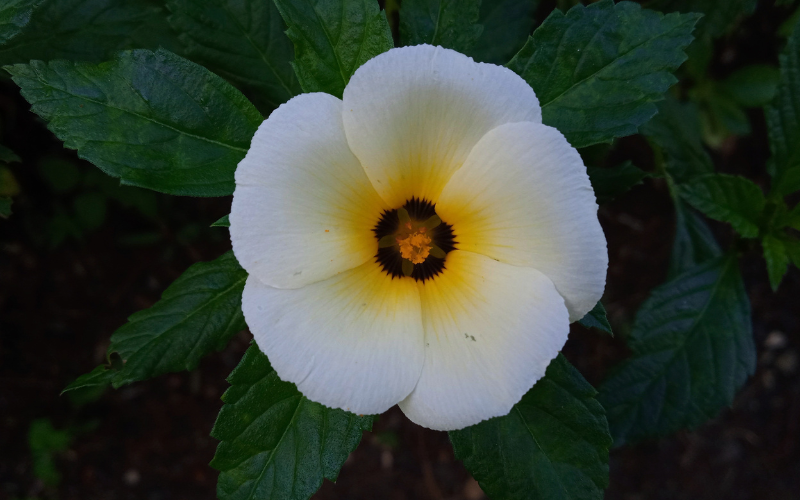
The White Buttercup flower is a stunningly beautiful and delicate flower. It is also known as the Ranunculus. The White Buttercup typically blooms in the spring.
White Buttercup flowers typically have five to eight petal-like sepals that are usually glossy and resemble the shape of a cup or bowl. The White Buttercup flower symbolizes charm and beauty, making it a popular choice for expressing love and admiration.
| Scientific Name | Ranunculus aquatilis |
| Native Range | Central and South America |
| Flowering Season | Spring and Summer |
Periwinkle
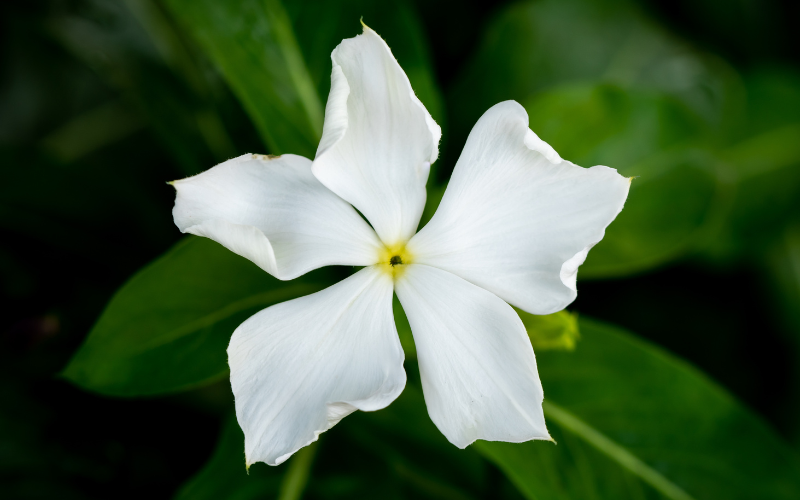
The periwinkle is a charming flower. It is also known by its botanical name Vinca minor. It is native to Europe. The flowers are typically a shade of blue or purple, although there are also white-flowered varieties available.
The flowering season of periwinkle typically occurs in the spring. Their low-maintenance nature makes them an ideal choice for busy gardeners.
| Scientific Name | Catharanthus |
| Native Range | Southern Switzerland southward around much of the Mediterranean basin, from Portugal to Turkey, and across much of North Africa |
| Flowering Season | Late spring to early summer |
Profusion Salvia
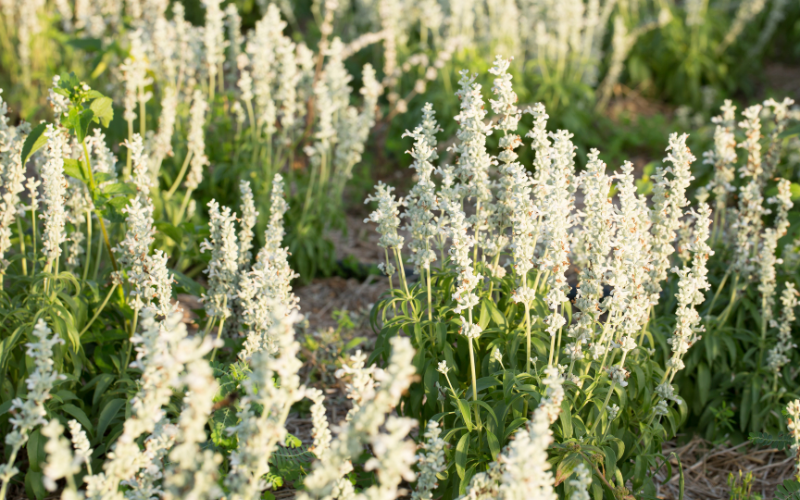
The Profusion Salvia is a stunning flower. These flowers come in a variety of shades, including vibrant red, purple, pink, and white. This flower is known for its ability to attract pollinators, such as bees and butterflies.
The Profusion Salvia Flower is relatively low maintenance, making it an ideal choice for both experienced and novice gardeners. It thrives in full sun and well-drained soil, and once established, it is fairly drought-tolerant, making it a great choice for hotter climates.
| Scientific Name | Salvia nemorosa |
| Native Range | Europe and west-central Asia |
| Flowering Season | Early spring and last until late summer |
Wisteria
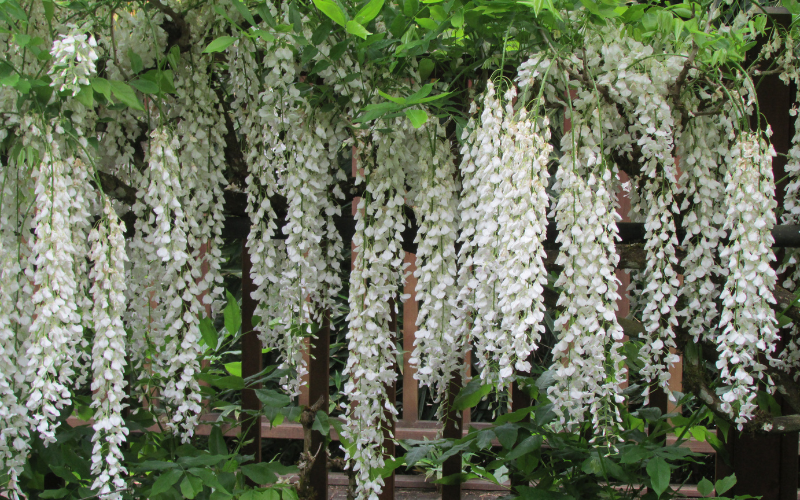
Wisteria is a beautiful flower. The flowers range in color from shades of white to blue, purple, and pink, depending on the species and variety. Wisterias typically flower in late spring to early summer.
Wisterias require proper pruning to maintain their shape and encourage flowering. Wisteria flowers hold cultural and symbolic significance in various cultures around the world.
| Scientific Name | Wisteria |
| Native Range | China, Japan, Korea, Vietnam, southern Canada, the Eastern United States, and North of Iran |
| Flowering Season | Early to mid-spring |
Mock Orange
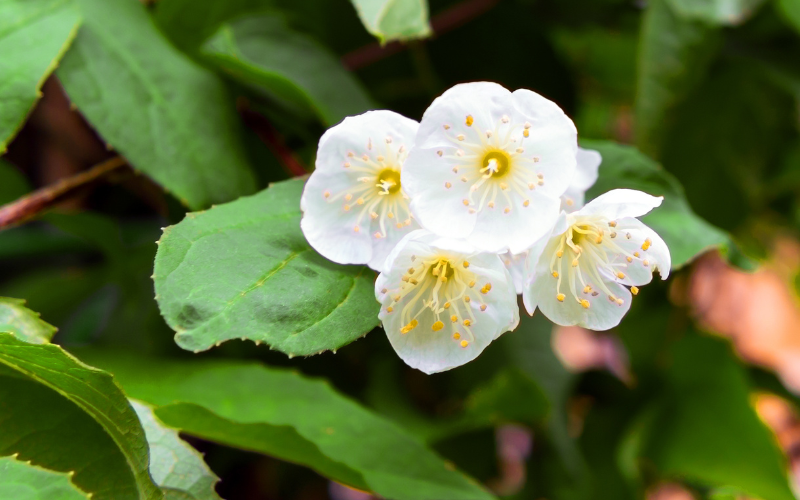
The mock orange is stunning and fragrant. It is also known as Philadelphus. Mock Orange flowers are typically white and have a simple yet elegant appearance. They are generally around 1 to 2 inches in diameter.
One of the most remarkable qualities of mock orange flowers is their strong and pleasant fragrance. Mock Orange typically blooms in late spring to early summer.
| Scientific Name | Philadelphus |
| Native Range | North America, Central America, Asia, and (locally) in Southeast Europe |
| Flowering Season | Late spring and summer |
Hellebore
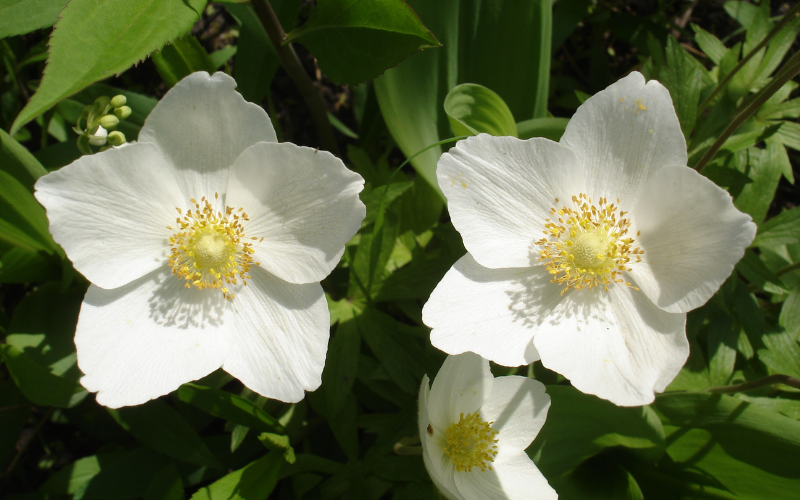
One beautiful and unusual flowering plant is the hellebore flower. It goes by the names Lenten Rose and Christmas Rose as well. Shades of white, cream, pink, purple, green, and even multicolored or spotted variations are among the colors of the blossoms.
During the Lenten season, hellebores bloom and they thrive in organic matter-rich, well-draining soil. They require little maintenance and can provide a long-lasting garden accent.
| Scientific Name | Helleborus |
| Native Range | Europe and farther into Turkey and then China |
| Flowering Season | Winter until spring |
Daffodil
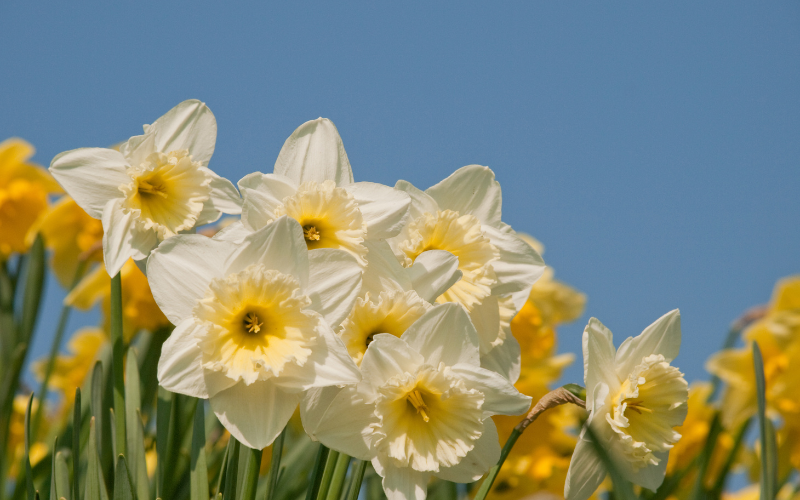
The Daffodil is a beautiful flower. It is scientifically known as Narcissus. It is native to Europe. The flowers can be white or cream-colored, while the corona can be various shades of yellow, orange, or even pink.
They typically start flowering from late winter to early spring. Daffodils are generally easy to grow and are suitable for a variety of garden settings. They prefer well-draining soil and thrive in full to partial sun.
| Scientific Name | Narcissus |
| Native Range | Meadows and Woods in Southern Europe and North Africa |
| Flowering Season | Late spring to early summer |
Cosmos
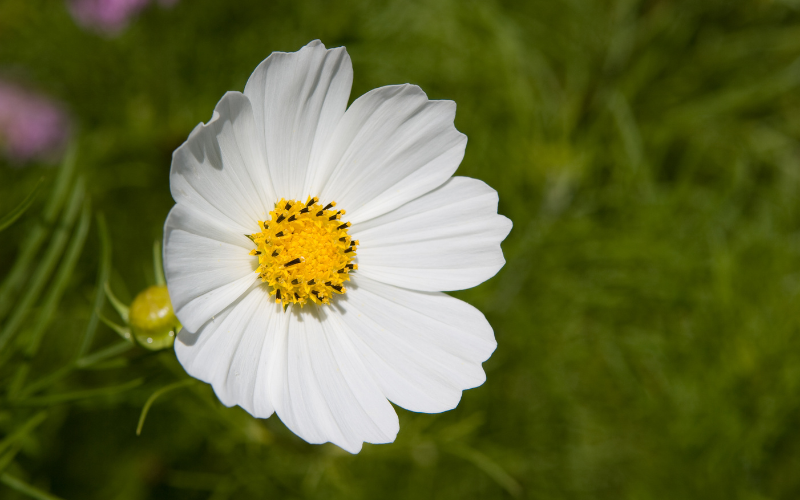
Cosmos is a beautiful flower. It is native to Mexico and the southern United States. Cosmos flowers come in a wide range of colors, including shades of white, pink, purple, red, orange, and even bi-colored varieties.
Cosmos flowers typically bloom in the late spring through fall, depending on the variety and local climate. Cosmos plants are usually tall and slender, and they can reach heights of up to several feet.
| Scientific Name | Cosmos |
| Native Range | Mexico |
| Flowering Season | Summer |
Allium
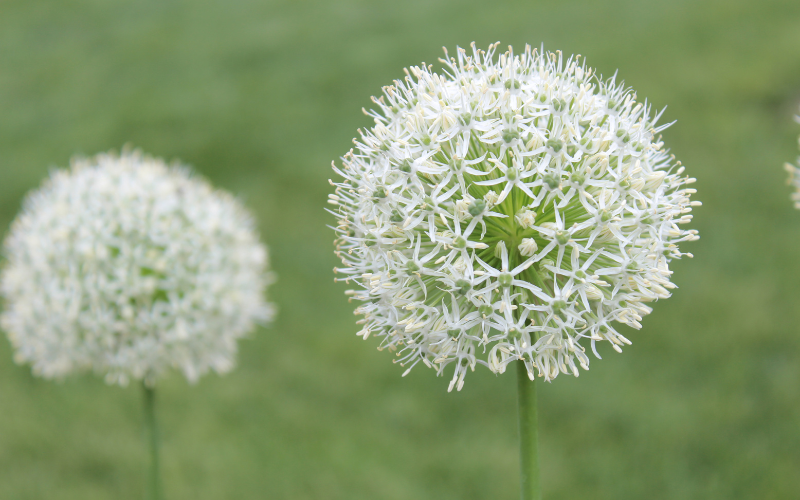
Allium is a lovely flower. Allium flowers are known for their unique, globe-shaped flower. They come in various shades of white, pink, purple, blue, and even yellow.
Alliums are relatively easy to grow and are suitable for a variety of garden settings. They typically prefer well-drained soil and full sun. It blooms in late spring to early summer.
| Scientific Name | Allium |
| Native Range | Northern Hemisphere |
| Flowering Season | Spring to Summer |
Bacopa
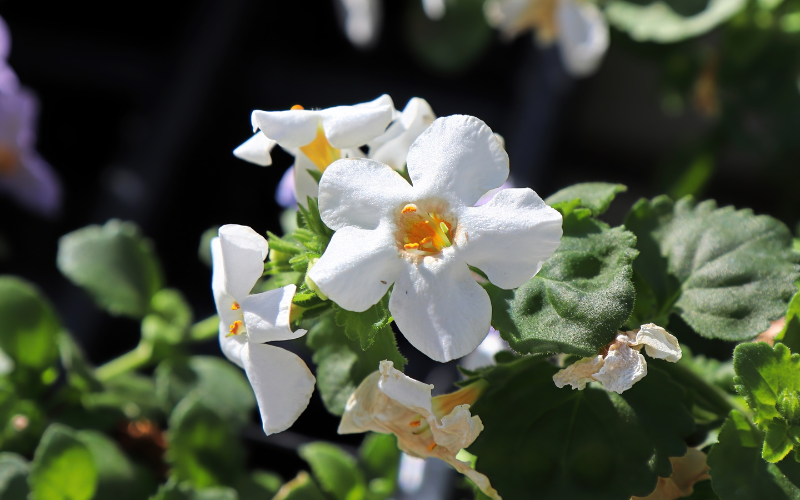
Bacopa is a charming flower. It is native to South Africa. The flowers can come in a range of white, lavender, pink, or blue. Bacopa is known for its adaptability and can thrive in a variety of conditions.
It prefers full to partial sun, but it can tolerate some shade. Bacopa monnieri, in particular, is well-known in traditional Ayurvedic medicine.
| Scientific Name | Pennell |
| Native Range | Southern and Eastern India, Australia, Europe, Africa, Asia, and North and South America |
| Flowering Season | Spring Until Autumn |
Calla Lily
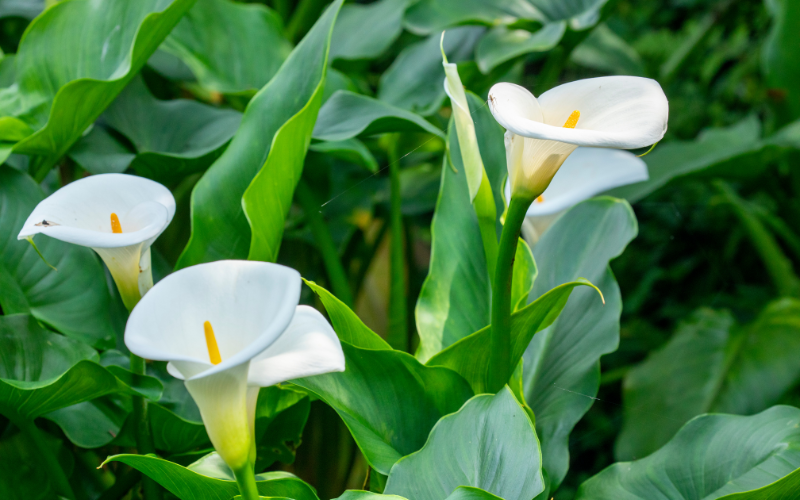
Calla Lily is a beautiful flower. It is also known as Zantedeschia. It is native to southern Africa. The flowers come in a range of white, cream, yellow, pink, and purple. Calla Lily plants vary in size, with some dwarf varieties reaching around 12 inches (30 cm) in height, while taller varieties can grow up to 36 inches (90 cm) or more.
Calla Lilies typically bloom in late spring to early summer. They prefer partial shade to full sun, making them versatile in terms of where they can be grown.
| Scientific Name | Zantedeschia |
| Native Range | South Africa |
| Flowering Season | Late spring and throughout the summer |
Amaryllis
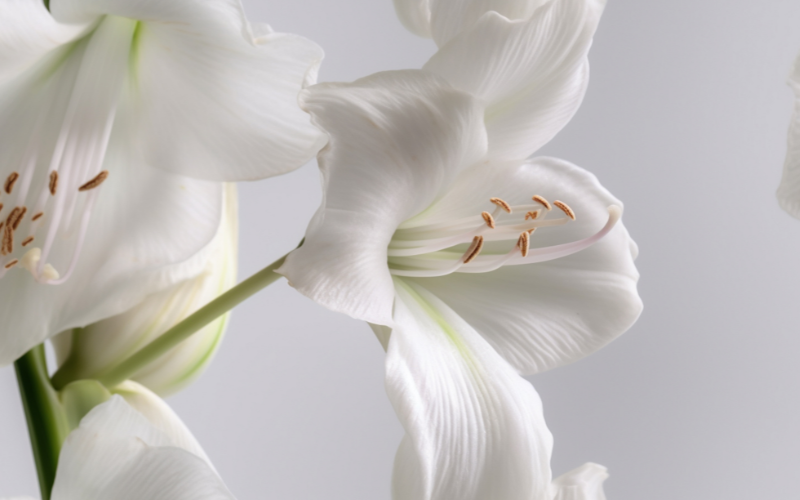
Amaryllis is a beautiful flower. It is also known as Hippeastrum spp. It is native to South America. Amaryllis flowers are known for their impressive, trumpet-shaped blossoms that come in various colors, including red, white, pink, salmon, orange, and bi-colored varieties.
The flowers can be as wide as 6 to 8 inches (15 to 20 cm). Amaryllis plants usually bloom in late winter or early spring.
| Scientific Name | Hippeastrum species |
| Native Range | Africa |
| Flowering Season | All Year Round |
Daisy
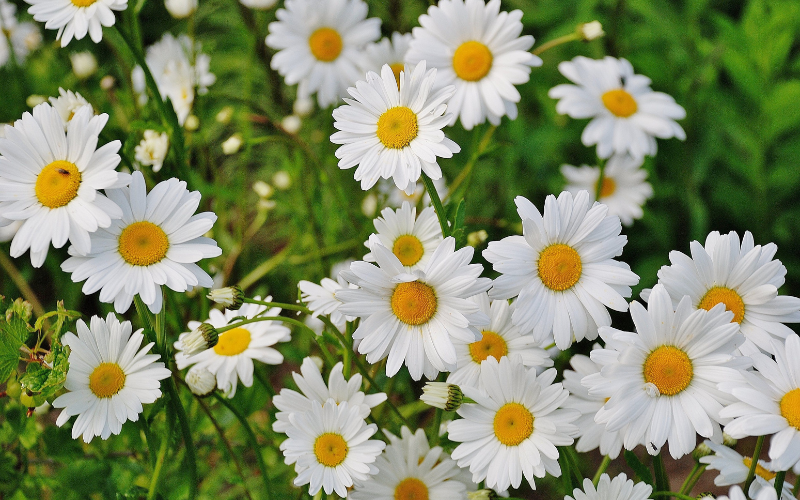
Flowers that bloom cheerfully and in great demand are daisies. It is a member of the Asteraceae family. In most cases, the ray florets are red, pink, white, or various degrees of these colors, with the central core being yellow.
As long as the soil drains properly, daisies are generally easy to cultivate and can tolerate a variety of soil types. Usually, daisies bloom in late spring or early summer.
| Scientific Name | Bellis perennis |
| Native Range | Europe and Asia |
| Flowering Season | Spring to Summer |
Camellia
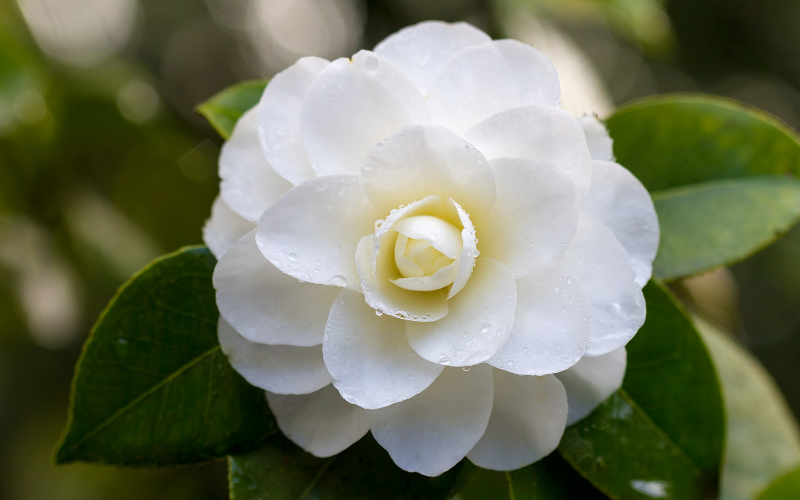
Camellia is a beautiful flower. It is native to Asia. The color of the flowers can vary widely, with shades of white, pink, and red. Camellias thrive in temperate climates and prefer partial shade or filtered sunlight.
They are sensitive to extreme heat and direct sunlight. It blooms in late winter or early spring. In some cultures, they symbolize longing or waiting for someone’s return.
| Scientific Name | Camellia japonica |
| Native Range | Eastern and Southern Asia |
| Flowering Season | Late fall to mid-spring |
Foxglove
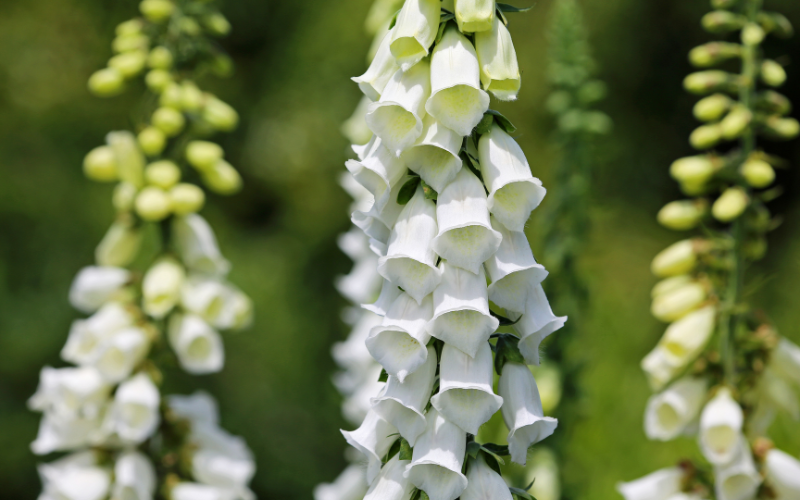
Foxglove is a charming flower. It is native to Europe. The flowers typically come in various shades of pink, purple, white, and sometimes yellow or cream.
Foxglove plants produce tall spikes of bell-shaped or tubular flowers that can reach heights of 3 to 6 feet (90 cm to 180 cm) or even taller. Foxgloves are relatively low-maintenance plants.
| Scientific Name | Digitalis |
| Native Range | Europe, North America |
| Flowering Season | Summer |
Gerbera Daisy

The Gerbera Daisy is stunning. It is native to South Africa. They typically grow to a height of 12 to 18 inches (30 to 45 cm), with flower stalks rising above the foliage. They typically flower from late spring through summer.
Gerbera daisies thrive in well-drained soil with a slightly acidic to neutral pH. They require full sun to light shade to produce the best blooms.
| Scientific Name | Gerbera jamesonii |
| Native Range | South Africa |
| Flowering Season | Late spring through autumn |
Arabian Jasmine
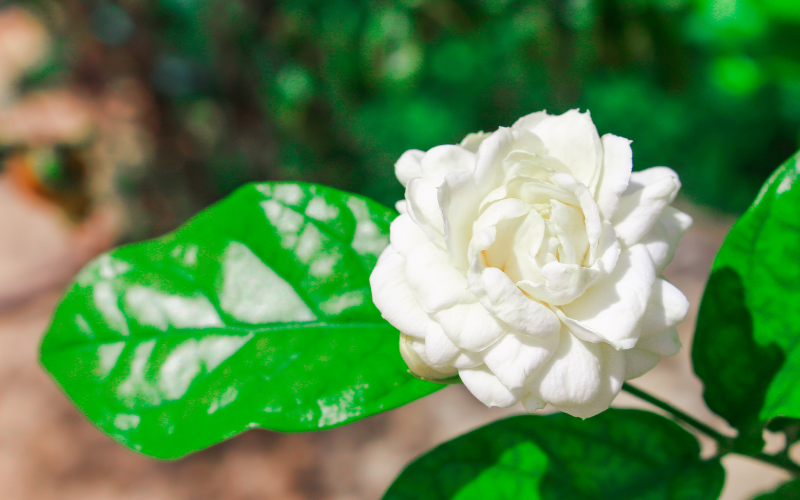
Arabian Jasmine is a fragrant flowering plant. It is scientifically known as Jasminum sambac. It is native to Southeast Asia. Arabian Jasmine is known for its small, white, star-shaped flowers.
Arabian Jasmine holds cultural and religious significance in many countries, particularly in South Asia. It prefers well-draining soil and a location with plenty of sunlight but also tolerates partial shade.
| Scientific Name | Jasminum sambac |
| Native Range | Asia |
| Flowering Season | Summer |
Peony
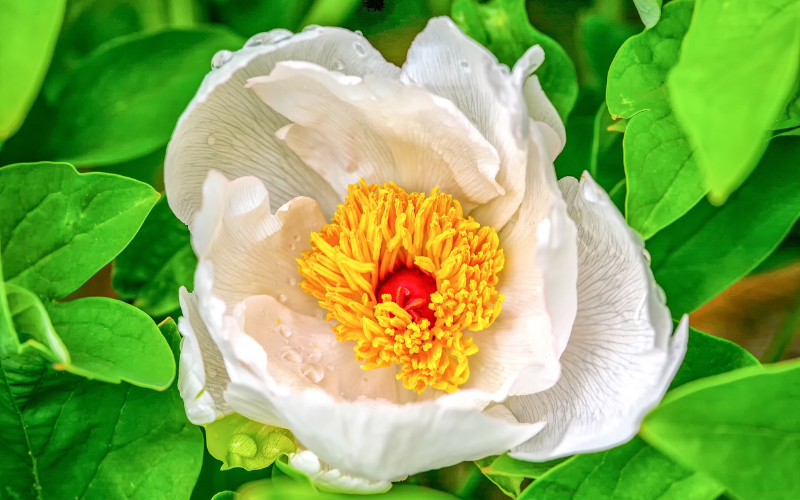
A peony is a beautiful flower. It is also known as Paeonia spp. It is Native to Asia. These flowers come in a wide range of colors, including white, pink, red, and even yellow. Peonies typically bloom in late spring to early summer.
They are relatively low-maintenance but require some care, including regular watering, fertilization, and division every few years to maintain vigorous growth.
| Scientific Name | Paeonia |
| Native Range | Asia, Europe, and Western North America |
| Flowering Season | Late spring – early summer |
White Lavender
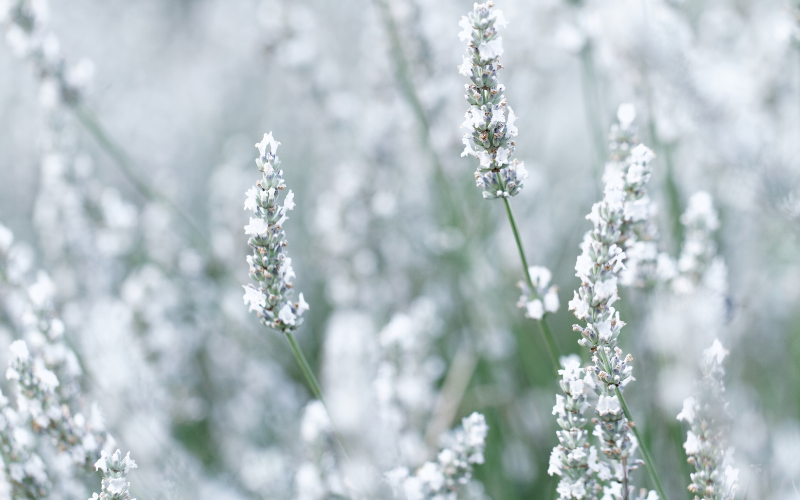
The white lavender blossom is lovely. Lavandula angustifolia is another name for it. The length of the flowers can range from 2 to 3 inches (or 5 to 7.5 cm). The flowering season for white lavender is usually late spring to early summer. It is frequently grown in pots, rock gardens, herb gardens, and as edging for sidewalks.
The adaptability and capacity of white lavender to flourish in a variety of climates is well known. Although it may tolerate significant drought after it’s grown, it prefers full sun and well-drained soil.
| Scientific Name | Lavandula angustifolia |
| Native Range | Southern Portugal and Southwest Spain |
| Flowering Season | Spring to Summer |
White City Spanish Bluebells
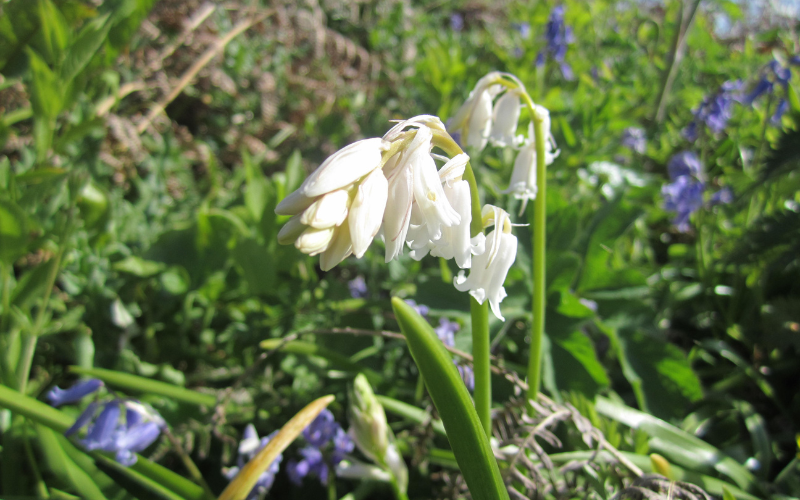
White City Spanish bluebells are a charming flower. It is also known as Hyacinthoides Hispanic ‘White City’. These Spanish bluebells have graceful, arching stems that bear clusters of small, bell-shaped flowers.
White City Spanish Bluebells are known for their tall, slender stems that can reach up to 60 centimeters in height. It typically blooms in the spring. They thrive in well-drained soil and can tolerate partial shade, making them suitable for a variety of garden environments.
| Scientific Name | Hyacinthoides hispanica White |
| Native Range | Spain, Portugal, and Northwest Africa |
| Flowering Season | Spring |
Lily
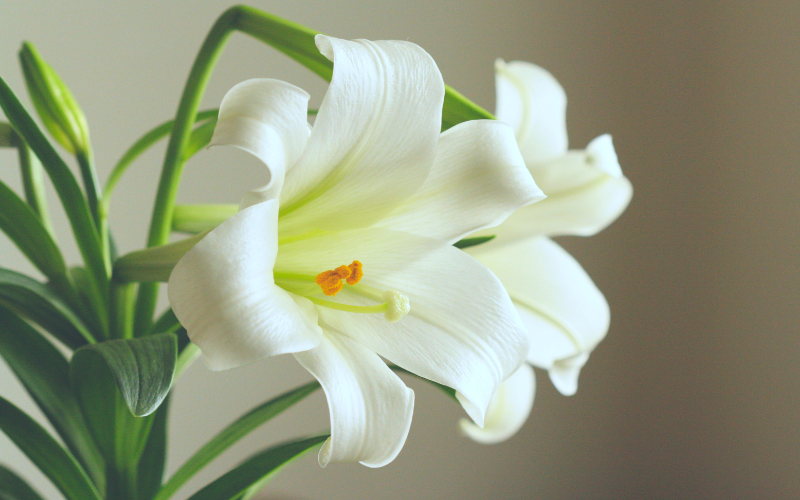
Lily is an amazing flower. They come in a wide range of colors, including white, yellow, orange, pink, red, and even bi-colored varieties. Lilies are primarily summer-blooming flowers. Lilies have deep cultural and symbolic significance.
They are often associated with purity, virtue, and renewal. Lilies prefer well-draining soil, ample sunlight, and regular watering. Proper care can help them thrive and produce more blooms in subsequent years.
| Scientific Name | Lilium |
| Native Range | North America, Europe, and Asia |
| Flowering Season | Monsoon season and spring seasonal summer |
Gooseneck Loosestrife
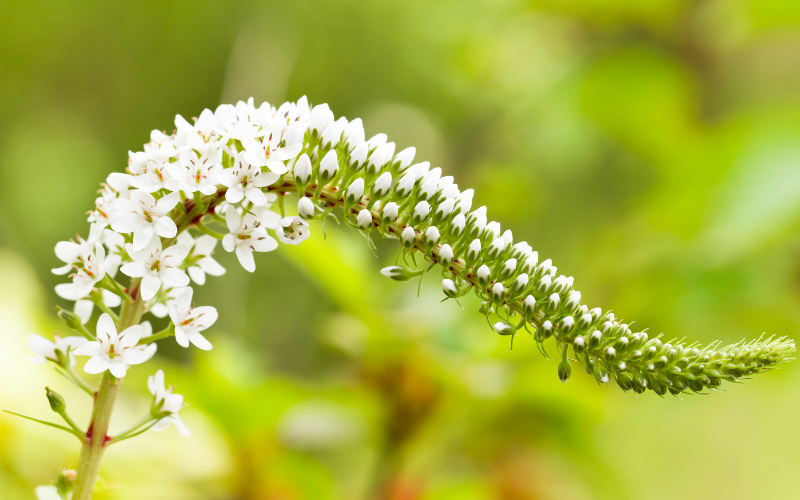
The Gooseneck Loosestrife flower is a stunning flower. It is scientifically known as Lysimachia clethroides. It is native to East Asia. The individual flowers are small and tubular, with five white petals.
This plant typically reaches a height of 2 to 3 feet (about 60 to 90 centimeters). It is blooms during the summer months. It prefers partial to full sun but can tolerate some shade.
| Scientific Name | Lysimachia clethroides |
| Native Range | Japan and China |
| Flowering Season | Summer |
Floristan White Liatris
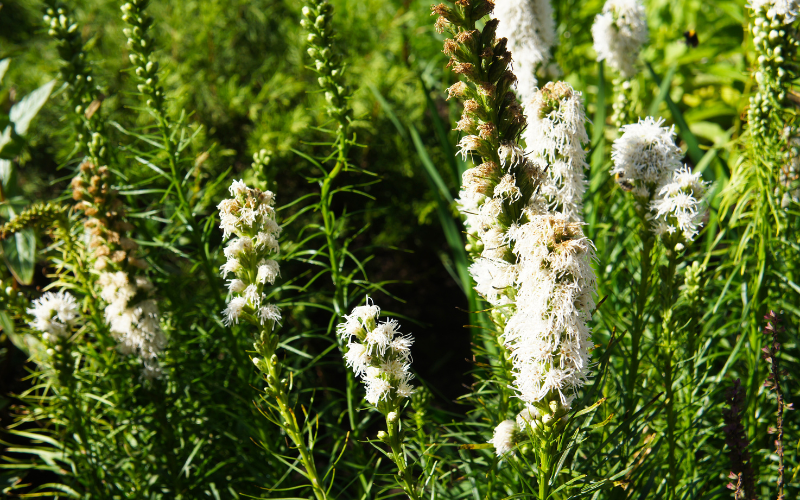
The Floristan White Liatris is a stunning and unique flower. It is scientifically known as Liatris spicata ‘Floristan White.’ It is native to North America. This plant typically grows to a height of 2 to 4 feet (approximately 60 to 120 centimeters).
It is blooms during the summer months. It prefers full sun and can tolerate dry conditions once established. This flower is relatively low-maintenance.
| Scientific Name | Liatris spicata |
| Native Range | United States |
| Flowering Season | Summer |
Scaevola
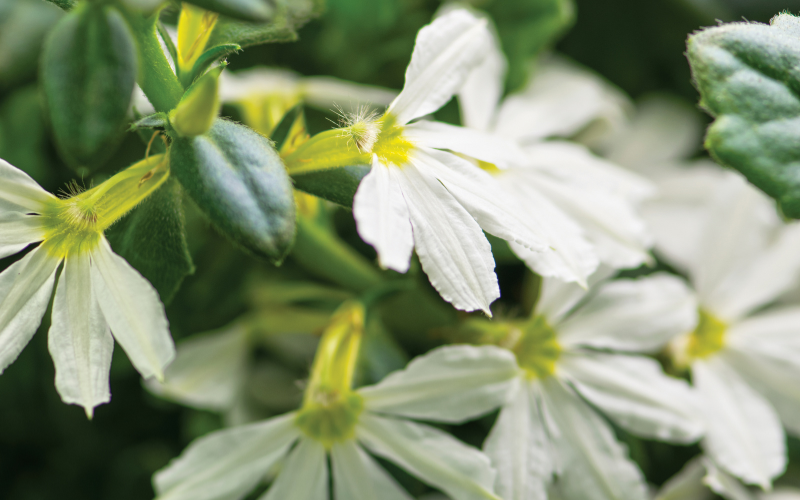
The Scaevola flower is a stunning flower. It is also known as the fan flower. It is native to Australia. Scaevola flowers come in a range of colors, including shades of blue, purple, pink, and white.
They typically measure around 1 to 2 inches (2.5 to 5 centimeters) in diameter. The Scaevola plants are low-growing and spreading, making them excellent ground covers or hanging basket plants.
| Scientific Name | Scaevola |
| Native Range | Australia |
| Flowering Season | Spring to Fall |
Clematis
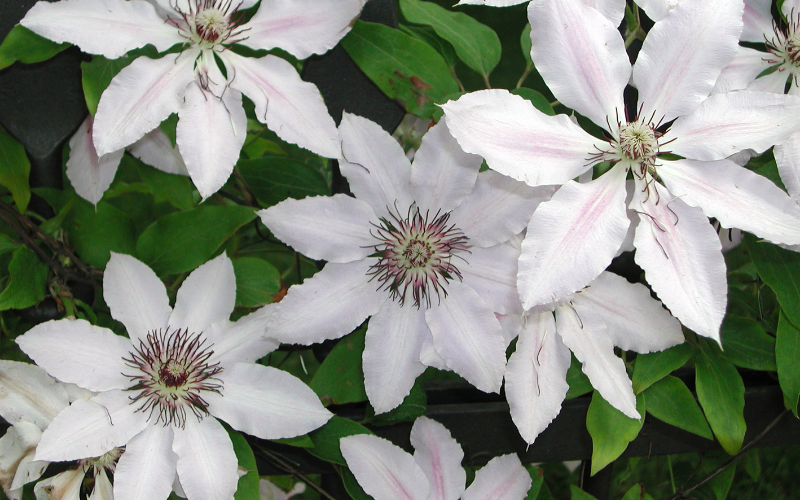
Clematis is a beautiful flower. This charming flower comes in a variety of colors, such as vibrant purples, pinks, and whites, creating a stunning visual display. The size of Clematis flowers can range from a few inches to several inches in diameter.
Clematis blooms at various times of the year, depending on the species or cultivar. Some flower in late spring, while others bloom in summer or early fall.
| Scientific Name | Clematis |
| Native Range | Japan, China, Europe and North America |
| Flowering Season | Summer |
Chrysanthemum
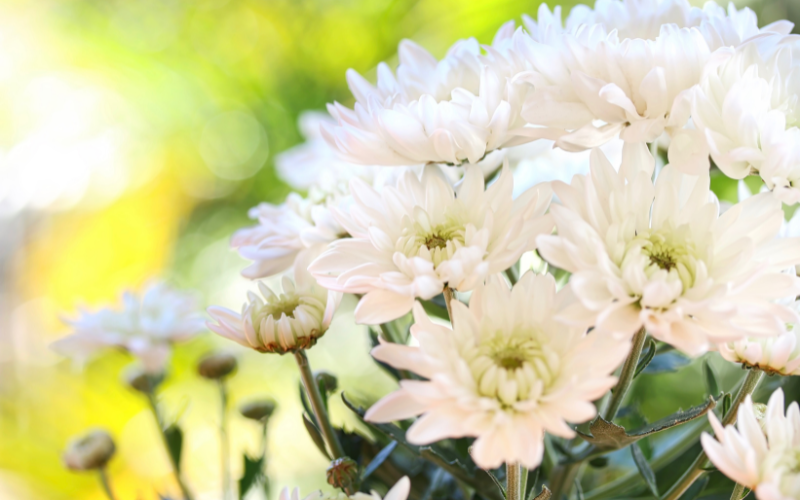
Chrysanthemum is a lovely flower. It is also known as “mums.” It is native to Asia and northeastern Europe. The flowers come in a wide variety of shapes, sizes, and colors including white, yellow, pink, red, purple, and bronze, among others.
Chrysanthemums are known for their late-season blooms, often flowering in the fall. Chrysanthemum also holds medicinal properties.
| Scientific Name | Chrysanthemum |
| Native Range | East Asia and northeastern Europe |
| Flowering Season | Late summer to fall |
Carnation
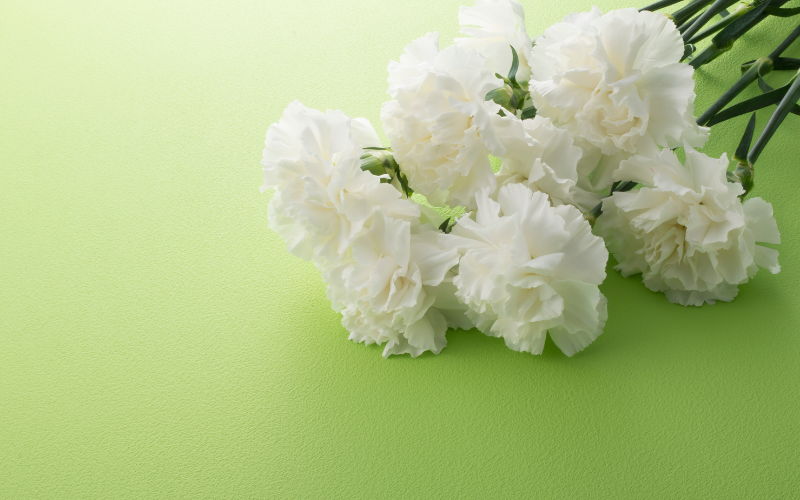
Carnation is a stunning flower. It is scientifically known as Dianthus caryophyllus. It is native to the Mediterranean region. Carnations come in a wide range of colors, including white, pink, red, yellow, and even green and purple.
They typically have a diameter of 2 to 3 inches (5 to 7.5 cm). Carnations can bloom throughout the year. Carnations require well-drained soil, moderate sunlight, and regular watering to thrive.
| Scientific Name | Dianthus caryophyllus |
| Native Range | Spain, Italy, Croatia, Albania, Greece and Turkey |
| Flowering Season | Spring |
Candytuft
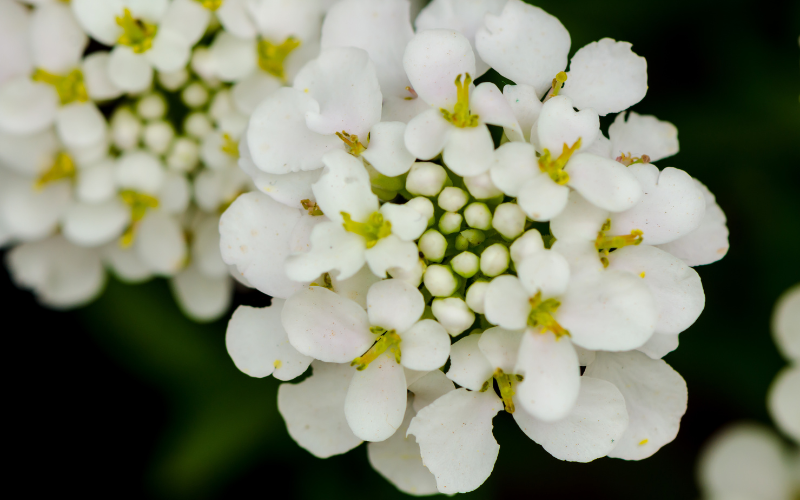
Candytuft is a beautiful flower. It is scientifically known as Iberis. It is native to Europe and parts of Asia. The flowers come in various shades, including white, pink, lavender, and purple.
Candytuft flowers are small, typically measuring around 1/2 to 1 inch (1.25 to 2.5 cm) in diameter. It is typically from late spring to early summer. Its low-growing habit also makes it suitable for rock gardens and containers.
| Scientific Name | Iberis |
| Native Range | Southern Europe and Western Asia |
| Flowering Season | Early spring through early to mid-summer |
